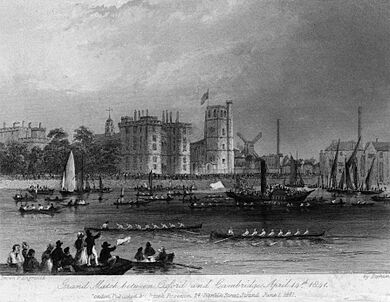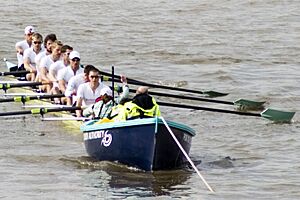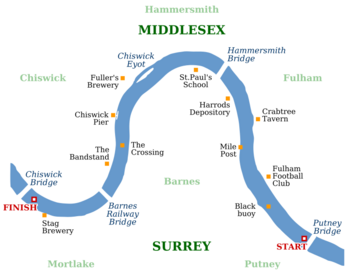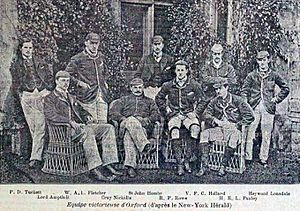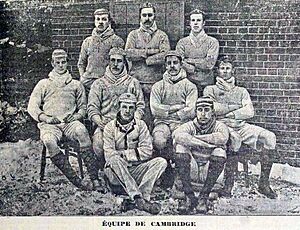The Boat Race facts for kids
 |
|
| Event information | |
|---|---|
| Race area | The Championship Course River Thames, London (2015 onwards, except 2021 on the River Great Ouse); Henley (1977 to 2014 except 2001 at NWSC and 2013 on Dorney Lake); The Isis, Oxford and River Cam, Cambridge (1927 to 1976 with several gaps); River Thames, London (1929, 1935) |
| Dates | 1927, annual since 1964 |
| Sponsor | Chanel (since 2025) |
| Competitors | CUBC, OUWBC |
| Distance | 4.2 miles (6.8 km) |
| First race | 15 March 1927 |
The Boat Race is a famous yearly rowing competition. It takes place between the rowing teams from Cambridge University Boat Club and Oxford University Boat Club. These races are usually held on the River Thames in London, England. The teams use special boats called "eights," which means they have eight rowers and one person steering.
The men's race first happened in 1829. It is one of the oldest university sports events in the world. It has been held every year since 1856, except during the two World Wars and the COVID-19 pandemic in 2020. The women's race started in 1927 and has been held every year since 1964. Since 2015, both the men's and women's races happen on the same day and course. Since 2018, the whole event is simply called "The Boat Race."
Most races happen on The Championship Course. This course is about 4.2 miles (6.8 km) long on the River Thames in West London. It goes from Putney to Mortlake. This is more than three times longer than an Olympic rowing race! The rowers are called "blues," and their boats are called "Blue Boats." Cambridge uses light blue, and Oxford uses dark blue.
As of the 2025 race, Cambridge has won the men's race 88 times, and Oxford has won 81 times. There has been one tie. In the women's race, Cambridge has won 48 times, and Oxford has won 30 times. Many people watch the race from the riverbanks, sometimes over 250,000! Millions more watch it on TV around the world.
Contents
History of the Men's Race
How the Race Started
The first Boat Race happened in 1829. It was started by two friends, Charles Merivale from Cambridge and Charles Wordsworth from Oxford. They had gone to the same school. Cambridge challenged Oxford to a race at Henley-on-Thames, but Oxford won easily. Oxford wore dark blue because many of their rowers were from Christ Church, a college whose color was dark blue.
The second race was in 1836, and it moved to a course in London. For a few years, the universities disagreed about where to race. But after the Oxford University Boat Club was officially formed, the races continued on the Tideway in London from 1839 onwards. Since then, the loser of the race usually challenges the winner to a rematch the next year.
The race has been held every year since 1856. The only times it was stopped were during World War I (1915-1919), World War II (1940-1945), and in 2020 due to the COVID-19 pandemic.
The 1877 Tie
In 1877, the race ended in a rare tie, also known as a dead heat. Both teams finished at the same time in bad weather. The judge, John Phelps, said the boats crossed the finish line exactly together. There were some stories that he was too old or couldn't see well, but he was known as "Honest John" and was fair. He had to decide without special finish posts, which were added for the next year's race.
Cancellations During World Wars
The Boat Race was completely cancelled during World War I (1915–1919) and World War II (1940–1945). This was because many young men from both universities went to fight in the wars.
The 1987 Oxford Team Problem
In 1986, Oxford lost the race for the first time in eleven years. An American rower named Chris Clark wanted to make sure Oxford won the next year. He brought four other American rowers and a cox (the person who steers the boat) to join the Oxford team. They wanted to create the fastest Boat Race crew ever.
However, there were disagreements about how the team should train. The American rowers even walked out of practice at one point. The coach, Dan Topolski, had to change his plans. There were also arguments about who should be in the boat. In the end, the American rowers were replaced by members of Oxford's reserve team. Even with these problems, Oxford won the race by four boat lengths, even though Cambridge was expected to win.
A book and a film were made about these events, called True Blue: The Oxford Boat Race Mutiny and True Blue.
The 2012 Race Stop
In 2012, the race had to stop for over 30 minutes. A protester swam into the water between the boats. An umpire spotted him, and the race was stopped for safety. When the race restarted, the boats bumped into each other, and an Oxford rower's oar broke. Cambridge then took the lead and won the race. Because of the stop, there was no official winning time recorded. The usual celebration after the race was also cancelled.
2020 Cancellation and 2021 Relocation
The 2020 Boat Race was completely cancelled because of the COVID-19 pandemic. In 2021, the races were moved to the River Great Ouse in Ely, Cambridgeshire. This was the first time since 1944 that the race was not on the Thames. It was moved because of safety concerns with Hammersmith Bridge and ongoing pandemic rules. The 2022 Boat Race returned to the traditional Thames course.
Boats Sinking
Sometimes, the boats can sink during the race, especially in bad weather. In 1912, both boats sank because of strong winds. Oxford's boat started taking on water and they tried to empty it, but Cambridge's boat also sank.
Cambridge's boat also sank in 1859 and 1978. Oxford's boat sank in 1925 and 1951. The 1951 race had to be re-rowed a few days later. In 1984, the Cambridge boat sank before the race even started after hitting another boat. The race was then held the next day. In 2016, the Cambridge women's boat started to sink but managed to finish the race.
History of the Women's Race
The Women's Boat Race started in 1927. For many years, it was run separately from the men's race. There were also differences in how the two events were treated. However, since 2015, the women's race has been held on the same course as the men's race. New training facilities have also been built for the women's teams, similar to those for the men.
Race Courses
The very first Boat Race in 1829 was at Henley-on-Thames. After that, the race was usually held on the River Thames, mostly on the Championship Course. The only exceptions were in 1944 and 2021, when it was moved to the River Great Ouse due to safety concerns and the COVID-19 pandemic.
The Championship Course
The Championship Course is 4 miles and 374 yards (about 6.78 km) long. It goes from Putney to Mortlake, passing through Hammersmith and Barnes. The course has an S-shape. The start and finish lines are marked by special stones on the riverbank.
Before the race, the team leaders flip a coin to decide which side of the river they will start on. They choose based on the weather, the river's current, and how the bends in the course might help their team. The north side (Middlesex) has an advantage on the first and last bends. The south side (Surrey) has an advantage on the longer middle bend.
During the race, the coxes try to steer their boat into the fastest part of the river. This can sometimes lead to the oars hitting each other. If one boat gets a lead of more than one boat length, it can move in front of the other team, making it very hard for the trailing boat to catch up. Because of this, teams usually try to start fast. It's rare for the leading team to change after the halfway point.
The race is rowed with the incoming tide, which means the boats are moving with the fast current. After the race, the winning team traditionally throws their cox into the Thames to celebrate!
Women's Race Courses
In its early years (1927-1976), the Women's Boat Race was held on different rivers, like The Isis in Oxford or the River Cam in Cambridge. It was a shorter distance, about 1,000 yards. On two occasions, in 1929 and 1935, it was held on the Thames in London.
From 1977 to 2014, the Women's Boat Race was part of the Henley Boat Races. It was a 2,000-meter course. However, since 2015, the women's race has been held on the same Championship Course as the men's race. The only exception was in 2021, when it was moved to the River Great Ouse due to the COVID-19 pandemic.
Media Coverage
The Boat Race has been filmed since 1895. It is now a big national event in Britain and is shown live on television every year. The women's race has also become very popular on TV since 2015. Millions of people watch it. The BBC has covered the men's race on radio since 1927 and on TV since 1938.
Competitors
Men's Race Rowers
Many famous rowers have taken part in the Boat Race, including Olympic champions. For example, Sir Matthew Pinsent, who won four Olympic gold medals, rowed for Oxford. Other Olympic gold medalists like James Cracknell and Tim Foster have also rowed for their universities.
Other well-known people who have competed include actor Hugh Laurie (Cambridge 1980) and TV presenter Dan Snow (Oxford 1999, 2000, 2001).
Student Status
Oxford University does not give sports scholarships to students when they apply. Students must meet the university's academic requirements, and sports do not affect their application. Cambridge University has some sports scholarships, but only for students who have already been accepted based on their academic achievements.
To make sure the race is truly between students, there was a debate in 2007. A Cambridge rower who won the race did not finish his academic course. This led to discussions about whether only students enrolled in courses lasting at least two years should be allowed to race.
Sponsorship
The men's race has had sponsors since 1976. The money from sponsors helps pay for equipment and travel during training. The sponsors' logos are usually on the teams' training gear and race kits.
For many years, the women's teams had to pay for themselves. But in 2011, Newton Investment Management became a sponsor for both women's teams. Later, BNY Mellon took over sponsorship of the men's race in 2013. From 2016 to 2018, BNY Mellon and Newton Investment Management gave their sponsorship to Cancer Research UK. From 2019 to 2021, the Royal National Lifeboat Institution (RNLI) was the main sponsor.
Since 2021, both the men's and women's races have had the same sponsor. Gemini, a cryptocurrency company founded by two former Oxford rowers, became the main sponsor. For the 2025 event, the French luxury brand Chanel became the main sponsor, and the race is now called The Chanel J12 Boat Race.
Other Oxford and Cambridge Races
Besides the main Boat Race, Oxford and Cambridge also have reserve teams. The men's reserve teams are called Isis (Oxford) and Goldie (Cambridge). The women's reserve teams are Osiris (Oxford) and Blondie (Cambridge). These reserve races happen on the same day as the main Boat Race. There is also a "veterans' boat race" for former rowers.
The universities also have "lightweight" teams for rowers who meet certain weight limits. The men's lightweight race started in 1975, and the women's in 1984. These races are also held on the Championship Course.
Statistics
Men's Race
- Number of wins: Cambridge, 88; Oxford, 81 (1 tie)
- Most wins in a row: Cambridge, 13 (from 1924 to 1936)
- Fastest time: Cambridge, 1998 – 16 minutes 19 seconds
- Closest win (not a tie): 1 foot (Oxford, 2003)
- Biggest win: 35 lengths (Cambridge, 1839)
Women's Race
- Number of wins: Cambridge, 48; Oxford, 30
- Fastest time: Cambridge, 2022 – 18 minutes 22 seconds
Results
- Men's Race
There have been 169 official men's races in 195 years.
| Decade | Total races | Cambridge wins | Oxford wins | Notes |
|---|---|---|---|---|
| 1820s | 1 | 0 | 1 | |
| 1830s | 2 | 2 | 0 | |
| 1840s | 7 | 5 | 2 | |
| 1850s | 6 | 2 | 4 | |
| 1860s | 10 | 1 | 9 | |
| 1870s | 10 | 7 | 2 | 1 dead heat |
| 1880s | 10 | 5 | 5 | |
| 1890s | 10 | 1 | 9 | |
| 1900s | 10 | 7 | 3 | |
| 1910s | 5 | 1 | 4 | |
| 1920s | 10 | 9 | 1 | |
| 1930s | 10 | 8 | 2 | |
| 1940s | 4 | 3 | 1 | |
| 1950s | 10 | 7 | 3 | |
| 1960s | 10 | 5 | 5 | |
| 1970s | 10 | 5 | 5 | |
| 1980s | 10 | 1 | 9 | |
| 1990s | 10 | 7 | 3 | |
| 2000s | 10 | 3 | 7 | |
| 2010s | 10 | 5 | 5 | |
| 2020s | 5 | 4 | 1 | |
| Total | 170 | 88 | 81 | 1 dead heat |
- Women's Race
There have been 75 women's races in 94 years.
Images for kids
See also
 In Spanish: Regata Oxford-Cambridge para niños
In Spanish: Regata Oxford-Cambridge para niños


